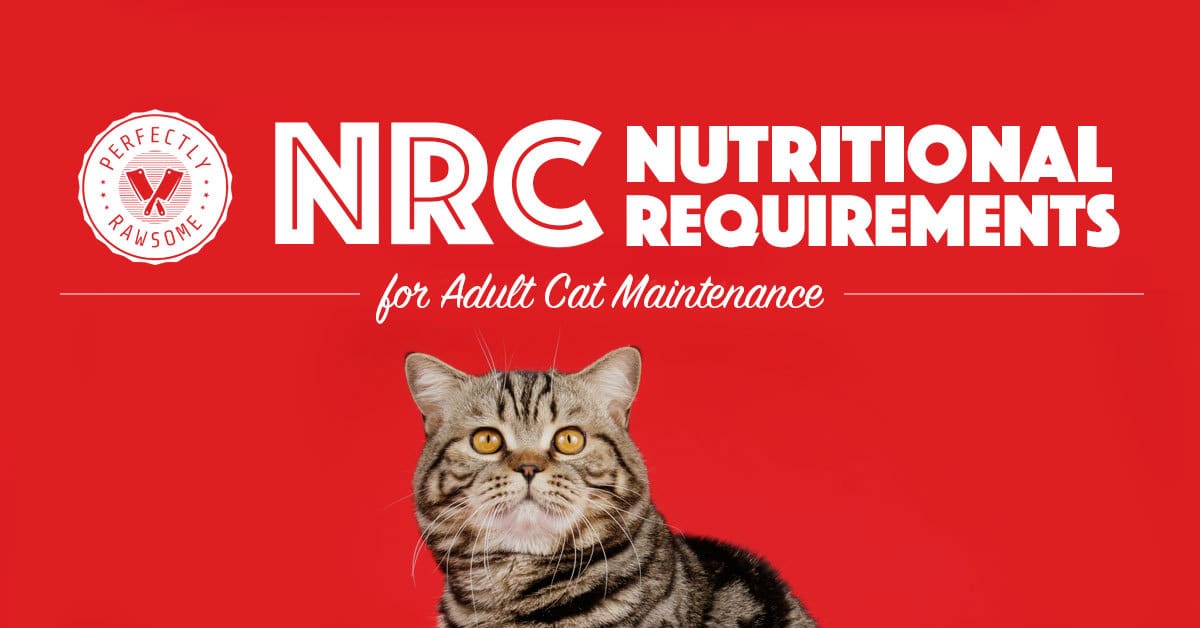Adult cats can regulate vitamins and nutrients, and their diet can achieve balance over time or daily. Prey Model Raw (PMR) diets provide guidelines on items to include in a raw diet to provide essential nutrients and recommended calories for optimal health.

Macronutrients for Adult Cats
Macronutrients are the first piece in nutrition where they are necessary for optimal health. There are three primary macronutrients which include protein, lipids (fats), and carbohydrates. Each macronutrient is in nearly all foods and supply calories for energy.
Recommended Daily Allowances for Macronutrients
Macronutrients are a class of chemical compounds which are consumed in large quantities and provide the bulk of energy within the diet.
Proteins are large complex molecules composed of amino acids and are the main structural component of body tissue. Adult cats do not have a nutritional requirement for protein because the body can synthesize new proteins with amino acids and nitrogen. However, adult cats have specific requirements for amino acids, carbon skeletons, and nitrogen.
Protein supplied in food provides essential amino acids, carbon skeletons, and nitrogen to fulfill nutritional requirements. The primary role of protein is to supply amino acids for muscle and organ protein synthesis, the creation of enzymes, the creation of hormones, and energy.
Nutritional Research Council (NRC) provides the following protein recommendations for adult cats 12 months and older per 1000kcal consumed:
Minimum: 40g
Recommended Allowance: 50g
Data Source:
National Research Council. Nutrient Requirements of Dogs and Cats. National Academies Press, 2007.
Fat provides nutritional compounds to supply adult cats with energy, essential fatty acids (EFAs), and is a vehicle for nutrient absorption and transportation. Fat is the primary source of energy for dogs and providing a raw diet with sufficient amounts of fat is important to optimal health.
Nutritional Research Council (NRC) provides the following fat recommendations for adult cats 12 months and older per 1000kcal consumed:
Minimum: 22.5g
Recommended Allowance: 22.5g
Data Source:
National Research Council. Nutrient Requirements of Dogs and Cats. National Academies Press, 2007.
Water accounts for a large portion of the total amount of food ingested in a normal raw diet. Water does not provide any nutritional value. However, water is an essential nutrient necessary for optimal feline health and nutrition.
Micronutrients for Adult Cats
Additionally, kittens have different micronutrient requirements in comparison to adult cats. Kittens have higher requirements for amino acids, fats, vitamins, and minerals in comparison to adult cats. Therefore, there must be a supply of these nutrients in sufficient amounts in the diet.
Recommended Daily Allowances for Essential Nutrients
Nutritional Research Council (NRC) provides the following Recommended Allowances (RA) for adult cats 12 months and older per 1000kcal consumed:
| Nutrient | RA | Minimum | Maximum |
|---|---|---|---|
| Arginine | 1.9 g | 1.9 g | – |
| Histidine | 0.7 g | 0.7 g | – |
| Isoleucine | 1.1 g | 1.1 g | – |
| Leucine | 2.6 g | 2.6 g | – |
| Lysine | 0.9 g | 0.7 g | – |
| Methionine | 0.4 g | 0.3 g | – |
| Methionine + Cystine | 0.9 g | 0.7 g | – |
| Phenylalanine | 1.0 g | 1.0 g | – |
| Phenylalanine + Tyrosine | 3.8 g | 3.8 g | – |
| Threonine | 1.3 g | 1.3 g | – |
| Tryptophan | 0.3 g | 0.3 g | – |
| Taurine | 0.1 g | 0.1 g | – |
Data Source:
National Research Council. Nutrient Requirements of Dogs and Cats. National Academies Press, 2007.
| Nutrients | RA | Minimum | Maximum |
|---|---|---|---|
| Linoleic Acid | 1.4 g | 1.4 g | 13.8 g |
| α-Linolenic Acid | – | – | – |
| Eicosapentaenoic + Docosahexaenoic Acid (EPA/DHA) | 0.025 g | – | – |
Data Source:
National Research Council. Nutrient Requirements of Dogs and Cats. National Academies Press, 2007.
| Nutrient | RA | Minimum | Maximum |
|---|---|---|---|
| Vitamin A | 250 mcg | 250 mcg | 25,000 RE* |
| Vitamin D | 1.8 mcg | 1.8 mcg | – |
| Vitamin E | 10 mg | 10 mg | – |
* Vitamin A: 1 IU is the biological equivalent of 0.3 micrograms (mcg) retinol
Data Source:
National Research Council. Nutrient Requirements of Dogs and Cats. National Academies Press, 2007.
| Nutrient | RA | Minimum | Maximum |
|---|---|---|---|
| Vitamin B1 (Thiamine) | 1.4 mg | 1.4 mg | – |
| Vitamin B2 (Riboflavin) | 1.0 mg | 1.0 mg | – |
| Vitamin B3 (Niacin) | 10 mg | 10 mg | – |
| Vitamin B5 (Pantothenic Acid) | 1.4 mg | 1.2 mg | – |
| Vitamin B6 (Pyridoxine) | 0.6 mg | 0.5 mg | – |
| Vitamin B9 (Folate & Folic acid) | 188 mcg | 150 mcg | – |
| Vitamin B12 (Cobalamin) | 5.6 mcg | 5.6 mcg | – |
| Biotin | 18.8 mcg | 18.8 mcg | – |
| Choline | 637 mg | 510 mg | – |
| Nutrient | RA | Minimum | Maximum |
|---|---|---|---|
| Calcium | 0.7 g | 0.4 g | – |
| Phosphorus | 0.6 g | 0.4 g | – |
| Magnesium | 100 mg | 50 mg | – |
| Sodium | 170 mg | 160 mg | – |
| Potassium | 1.3 mg | 1.3 mg | – |
| Chloride | 240 mg | 240 mg | – |
Data Source:
National Research Council. Nutrient Requirements of Dogs and Cats. National Academies Press, 2007.
| Nutrient | RA | Minimum | Maximum |
|---|---|---|---|
| Iron | 20 mg | 20 mg | – |
| Copper | 1.2 mg | 1.2 mg | – |
| Zinc | 18.5 mg | 18.5 mg | – |
| Manganese | 1.2 mg | 1.2 mg | – |
| Selenium | 75 mcg | 75 mcg | – |
| Iodine | 450 mcg | 320 mcg | – |
Data Source:
National Research Council. Nutrient Requirements of Dogs and Cats. National Academies Press, 2007.
When combining recommended allowances for essential nutrients with raw feeding ratio guidelines, a balanced raw diet using whole foods can be achieved to supply an adult cat with the appropriate nutrition to support optimal feline health and nutrition.
Raw Feeding Ratio Guidelines
A raw diet is divided into percentages, known as ratio guidelines, to provide an estimate on how much of each ingredient is needed. Ratios from PMR diets are guidelines for the amount of muscle meat, raw meaty bones, and organs, to include in a raw diet for an adult cat.
Similar to maintenance percentages, raw diet ratios are to be used as a guideline when selecting ingredients and creating a raw diet. Once maintenance percentages are calculated, ratio guidelines can be determined.
Example 1
Adult cat profile in english units:
6 Years Old
Low Activity
8 Pounds
Ideal Body Weight
300 Daily Calories
5oz Intake
Estimated Daily Intake
Calculate ratio guidelines in english units:
PMR Ratios
5 x 0.84 = 4.2oz muscle meat
5 x 0.06 = 0.3oz edible bone
5 x 0.05 = 0.25oz liver
5 x 0.05 = 0.25oz other organ
Example 2
Adult cat profile in metric units:
6 Years Old
Low Activity
3.6 Kilograms
Ideal Body Weight
300 Daily Calories
142g Intake
Estimated Daily Intake
Calculate ratio guidelines in metric units:
PMR Ratios
142 x 0.84 = 119g muscle meat
142 x 0.06 = 9g edible bone
142 x 0.05 = 7g liver
142 x 0.05 = 7g other organ
Adapting Ratio Guidelines into a Balanced Diet
Ratio calculations provide a guideline on ingredients to include in a raw diet. Each ingredient provides essential nutrients to use when formulating a balanced raw diet for adult cats.
Muscle Meat
The muscle meat portion of raw ratios assists in supplying protein, amino acids, fats, vitamins (water soluble B vitamins), and some minerals.
Raw Meaty Bones
The main role of the edible bone ratio is to supply calcium within a raw diet. Raw meaty bones provide muscle meat and edible bone which assists in supplying protein, amino acids, fats, and minerals (calcium and phosphorus).
Liver & Secreting Organs
The liver and other organ ratios assists in supplying protein, amino acids, vitamins (vitamin A and B vitamins), and minerals (iron and copper).
CLOSING COMMENTS
Adult cats can regulate nutrients, and their diet can achieve balance over time or daily. The diet must provide recommended allowances for essential nutrients to maintain optimal health.
Macronutrients
Macronutrients consist of protein, fat, and carbohydrates to provide calories for energy.
Micronutrients
Amino acids, fatty acids, vitamins, and minerals are all essential nutrients necessary for optimal health.
Raw Diet Ratios
The ratios for muscle meat, raw edible bone, and organs provide a guide on which ingredients to select to include in a raw diet for adult cats.
Raw diet ratios provide guidance on which ingredients and their amounts to use when formulating an adult cat. However, it is important to note these are starting guidelines, these are not “rules,” and adjustments should be made to complete recommended allowances for essential macro and micronutrients.
